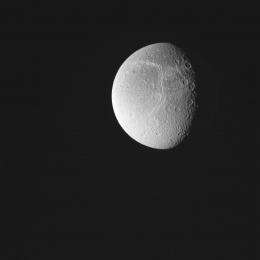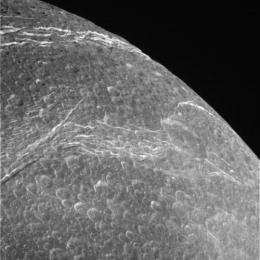Divine dione captured by Cassini

Cruising past Saturn's moon Dione this past weekend, NASA's Cassini spacecraft got its best look yet at the north polar region of this small, icy moon and returned stark raw images of the fractured, cratered surface.
The new images also show new views of the long, bright canyon ice walls, which scientists working with NASA's Voyager spacecraft called "wispy terrain" in the early 1980s. These ice walls thread along the surface of the moon's trailing hemisphere and cut across craters.

The Cassini-Huygens mission is a cooperative project of NASA, the European Space Agency and the Italian Space Agency. JPL, a division of the California Institute of Technology in Pasadena, manages the mission for NASA's Science Mission Directorate, Washington, D.C. The Cassini orbiter and its two onboard cameras were designed, developed and assembled at JPL. The imaging operations center is based at the Space Science Institute in Boulder, Colo.
More raw images of Dione are available at saturn.jpl.nasa.gov/photos/raw/ .
More information: More information about the Cassini-Huygens mission is at http://www.nasa.gov/cassini and http://saturn.jpl.nasa.gov
Provided by JPL/NASA














